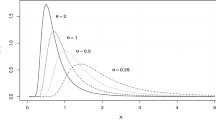Abstract
The problem of constructing statistical intervals for two-parameter Maxwell distribution is considered. An appropriate method of finding the maximum likelihood estimators (MLEs) is proposed. Constructions of confidence intervals, prediction intervals and one-sided tolerance limits based on suitable pivotal quantities are described. Pivotal quantities based on the MLEs, moment estimators and the modified MLEs are proposed and compared the statistical intervals based on them in terms of expected widths. Comparison studies indicate that the statistical intervals based on the MLEs offer little improvements over other interval estimates when sample sizes are small, and all intervals are practically the same even for moderate sample sizes. R functions to compute various intervals are provided and the methods are illustrated using two examples involving real data sets.


Similar content being viewed by others
References
Arslan T, Acitas S, Senoglu B (2021) Parameter estimation for the two-parameter Maxwell distribution under complete and censored samples. REVSTAT Stat J 19:237–253
Aryal S, Bhaumik DK, Mathew T, Gibbons R (2008) Approximate tolerance limits and prediction limits for the gamma distribution. J Appl Stat Sci 16:253–261
Chen P, Wang BX, Ye Z-S (2019) Yield-based process capability indices for nonnormal continuous data. J Qual Technol 51:171–180
Dey S, Dey T, Alic S, Mulekar S (2016) Two-parameter Maxwell distribution: properties and different methods of estimation. J Stat Theory Pract 10:291–310
Dumonceaux R, Antle CE (1973) Discrimination between the lognormal and Weibull distribution. Technometrics 15:923–926
Gibbons RD (1994) Statistical methods for groundwater monitoring. Wiley, Hoboken
Hoang-Nguyen-Thuy N, Krishnamoorthy K (2021) A method for computing tolerance intervals for a location-scale family of distributions. Comput Stat 36:1065–1092
Hoang-Nguyen-Thuy N, Krishnamoorthy K (2021) Estimation of the probability content in a specified interval using fiducial approach. J Appl Stat 48:1541–1558
Krishnamoorthy K, Waguespack D, Hoang-Nguyen-Thuy N (2019) Confidence interval, prediction interval and tolerance limits for a two-parameter Rayleigh distribution. J Appl Stat 47:160–175
Krishnamoorthy K, Mathew T, Mukherjee S (2008) Normal based methods for a gamma distribution: prediction and tolerance interval and stress-strength reliability. Technometrics 50:69–78
Krishnamoorthy K, Lin Y, Xia Y (2009) Confidence limits and prediction limits for a Weibull distribution. J Stat Plan Inference 139:2675–2684
Lawless JF (2003) Statistical models and methods for lifetime data. Wiley, Hoboken
Maxwell JC (1860) Illustrations of the dynamical theory of gases. Part I. On 36 the motions and collisions of perfectly elastic spheres. Philos Mag 37 4th series 19:19–32
Nicolas MD, Padgett WJ (2006) A bootstrap control chart for Weibull percentiles. Qual Reliab Eng Int 22:141–151
Thoman DR, Bain LJ, Antle CE (1969) Inferences on the parameters of the Weibull distribution. Technometrics 11:445–446
Tiku ML (1967) Estimating the mean and standard deviation from a censored normal sample. Biometrika 54:155–165
Tiku ML (1968) Estimating the parameters of Normal and Logistic distributions form censored samples. Aust J Stat 10:64–74
Tyagi RK, Bhattacharya SK (1989) Bayes estimation of the Maxwell’s velocity distribution function. Stat anno XLIX 4:563–567
Tyagi RK, Bhattacharya SK (1989) A Note on the MVU estimation of reliability for the Maxwell failure distribution. Estadistica 41:73–79
Acknowledgements
The authors are grateful to two reviewers for providing useful comments and suggestions.
Author information
Authors and Affiliations
Corresponding author
Ethics declarations
Conflict of interest
On behalf of all authors, the corresponding author states that there is no conflict of interest.
Additional information
Publisher's Note
Springer Nature remains neutral with regard to jurisdictional claims in published maps and institutional affiliations.
Appendices
Appendix A
We here derive an interval based on a sample of size n that would include the location parameter \(\mu \) with a specified probability. The derivation below is similar to the one by Hoang-Nguyen-Thuy and Krishnamoorthy (2020) for Rayleigh distributions. Let \(X_{(1)}\) denote the smallest order statistic for a sample of size n from a Maxwell\((\mu ,\sigma )\) distribution. Note that the distribution of \(X_{(1)}\) is given by
where \(F(x|\mu ,\sigma )\) is the CDF in (3). For a given \(P \in (0,1)\), let us determine the value of t so that \(P\left( X_{(1)}-t \le \mu \le X_{(1)}\right) = P(\mu \le X_{(1)} \le \mu +t)=P\). Let \(G(x|\Gamma (3/2))\) denote the gamma distribution function with the shape parameter 3/2 and the scale parameter 1. For a given P, we need to determine t so that
Solving the above equation for t, we obtain
where \(G^{-1}(q|a)\) is the quantile function of gamma(a, 1). In practice, \(\sigma \) is unknown, and so using the moment estimate \(\widehat{\sigma }_M\), we estimate t by
Note that we estimated the value of t by replacing \(\sigma \) by \(\widehat{\sigma }_M\). By choosing \(P = .999\), the interval \(\left( X_{(1)}-\widehat{t}, \ X_{(1)}\right) \) is expected include with high probability.
Appendix B




Rights and permissions
About this article
Cite this article
Chowdhury, F.A., Krishnamoorthy, K. Statistical Intervals for Maxwell Distributions. J Stat Theory Pract 16, 45 (2022). https://doi.org/10.1007/s42519-022-00270-y
Accepted:
Published:
DOI: https://doi.org/10.1007/s42519-022-00270-y




